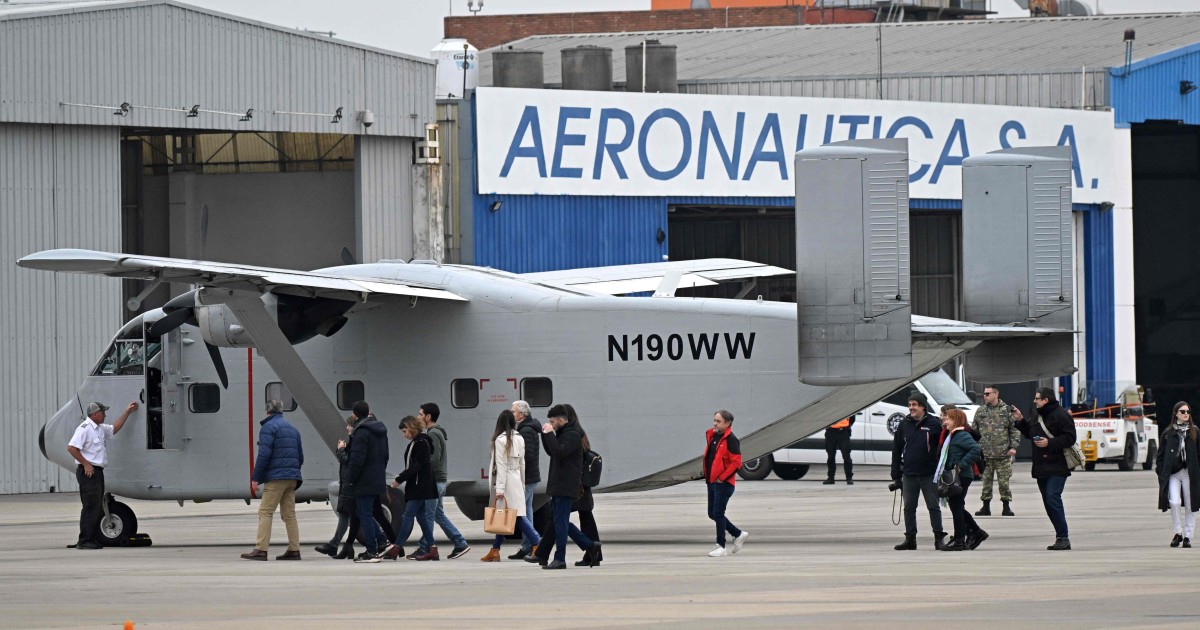BUENOS AIRES, Argentina — Flying from Florida to Buenos Aires usually takes about 10 hours, but the turboprop landing in Argentina on Saturday was no normal plane. It had been en route for 20 days, and many Argentines eagerly refreshed flight tracking software to keep tabs on its progress.
The Short SC.7 Skyvan carried no crucial cargo nor VIP passengers. Rather, the plane will be another means for Argentines to reckon with the brutal history of their country’s 1976-1983 military dictatorship.
The plane, which was discovered in the U.S., is the first ever proven in a court to have been used by Argentina’s junta to hurl political detainees to their deaths from the sky, one of the bloody period’s most cold-blooded atrocities.
Argentina’s government will add the plane to the Museum of Memory, which is in what was the junta’s most infamous secret detention center. Known as the ESMA, it housed many of the detainees who were later tossed alive from the “death flights” into the ocean or river
One of the victims linked to the returned plane was Azucena Villaflor, whose son Néstor disappeared and presumably was murdered early in the dictatorship. After he went missing, she founded the group Mothers of Plaza de Mayo to demand information about disappeared children, and then was herself detained and killed.
“For us, as family members, it’s very important that the plane be part of history, because the bodies as well as the plane tell exactly what happened,” Cecilia De Vincenti, Villaflor’s daughter, told The Associated Press.
The plane’s return was enabled by Italian photographer Giancarlo Ceraudo, who spent years seeking out “death flight” planes. This one had later delivered mail in Florida and more recently carried skydivers in Arizona.
Throughout his quest, Ceraudo said, countless people failed to understand why he remained steadfastly focused on finding the junta’s aircraft, especially since the bodies of many of the dictatorship’s victims are still undiscovered.
“The planes had to be recovered because they were an important piece, like the (Nazi) gas chambers, a terrible tool,” Ceraudo said in an interview.
Argentina’s junta is widely considered the most deadly of the military dictatorships that ruled much of Latin America in the 1970s and 1980s. It detained, tortured and killed people suspected of opposing the regime. Human rights groups estimate 30,000 were slain, many of whom disappeared without a trace.
Some of them vanished aboard the “death flights.”
During an extensive 2012-2017 trial, survivors testified that the flights took place at least weekly. According to witnesses, prisoners often were told that they were being released and sometimes were forced to dance to loud music in celebration. Then they received a supposed vaccination that was in fact a strong sedative. As the drug took effect, they were hooded, bound and loaded aboard a plane.
The trial, at which 29 former officials were sentenced to life in prison, proved that the dictatorship used death flights as a systematic mode of extermination. It specified that the Skyvan just returned to Buenos Aires was used to kill Villaflor and 11 other detainees.
Prosecutors say it is impossible to know how many detainees in all were thrown from the planes. But at least 71 bodies of suspected death flight victims washed up along the coast — 44 in Argentina and 27 in neighboring Uruguay, according to the Argentine Forensic Anthropology Team, a non-governmental group.
Between December 1977 and February 1978, the bodies of five women, including Villaflor, two other members of the Mothers of Plaza de Mayo and two French nuns who were helping mothers search for their loved ones washed up. They were buried without identification, and their bodies were not identified until 2005.
Ceraudo teamed up with Miriam Lewin, a journalist and ESMA survivor, in the search for the planes.
The pilots of the flight that carried Villaflor to her death were convicted in part due to flight logs that Ceraudo and Lewin were able to find after tracking down the PA-51 Skyvan in Fort Lauderdale, Florida, in 2010.
“The records led us to the pilots, and from those names, we were able to locate them within the repressive structures that operated in the service of the systematic extermination plan,” said Mercedes Soiza Reilly, who was prosecutor in the 2012-2017 trial.
Through a painstaking search that included deep dives into websites in which plane spotter hobbyists kept track of aircraft, Ceraudo and Lewin were able to locate the planes.
Of the five Skyvan planes known to have been used in death flights, two had been destroyed in the 1982 war with Britain over the Falkland Islands. The three others were sold in 1994 to CAE Aviation, a Luxembourg-based firm. One of those planes was sold to GB Airlink, which used it to provide private mail services to the Bahamas from Florida.
This year, after Argentina’s government decided to buy the plane after a campaign by De Vincenti and other human rights activists, it was located in a skydiving outfit in Phoenix.
“What an incredible story, right?” said De Vincenti. “Because they were thrown out without a parachute, and now they’re using it for that, for parachuting.”
Getting such an old plane back was not easy. It was stuck in Jamaica for two weeks after its engine broke shortly after takeoff from the island. It was also stuck for a few days in Bolivia due to inclement weather.
In seeking justice for the junta’s victims, Argentina has held 296 trials relating to dictatorship-era crimes against humanity since 2006, after amnesty laws were struck down. In those, 1,115 people have been convicted, according to the Public Prosecutor’s Office.
Putting the plane on display will help Argentines understand the reality of the dictatorship, activists say.
“It is very important, because there are generations upon generations who were born and lived in democracy and did not suffer the terror of those years,” Lewin said.


